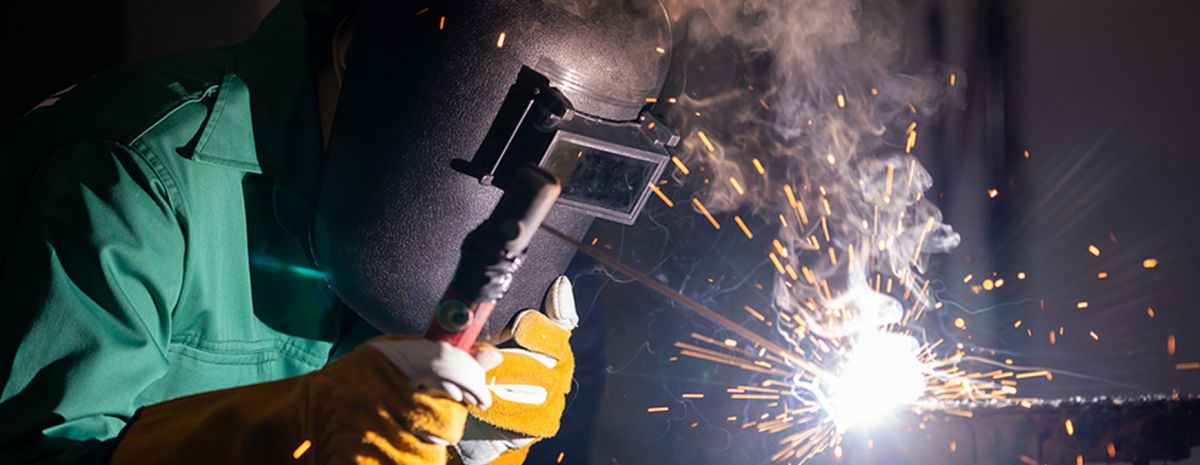
It can take detailed work, strength, stamina and dexterity to learn welding and be successful at it. Any beginner welder is likely to come across some challenges as they practice their skills.
Don’t give up! Just spend the time necessary to understand and diagnose the problems you are having, then work on building the skills you need to make a clean, beautiful weld—every time.
Here are 5 common welding problems that beginner welders may need to troubleshoot during the welding process.
(Keep in mind, there are more than 100 different types of welding a welder might use across thousands of different manufacturing activities. If you want in-depth practice, consider enrolling in a vocational training program for hands-on guidance from experienced welding instructors.)
1. Slag Inclusion
Slag is the by-product of welding and other metallurgical processes, created by impurities in the metals. Slag often contains minerals such as silicon, sulfur, aluminum, or ash.
Have You Considered a Career in the Skilled Trades?
Fill out the form to recieve a no obligation info packet.
Slag inclusion occurs when some unwanted particle is trapped in the weld metals or the base.
Slag inclusion can occur due to low amperage settings, too much weaving width, the length of the arc or a narrow groove. To prevent slag inclusion, use appropriate groove angles and amp parameters, keep the weld axis in the horizontal welding position and remove slag as much as possible.
2. Cracks
Cracks are a serious welding issue and can lead to complete weld failure. There are different types of cracks, including cold cracks and hot cracks, so learning how to prevent all types of welding cracks should be taken very seriously.
Cracks can become larger over time, and the solution is not as simple as just filling the crack. The crack needs to be ground out and a new weld needs to be performed over the affected area.
It’s much better to prevent cracks in the first place, and this can be done by making sure to spend enough time grinding, cleaning, and filing the edges of plates so they fit together.
Also, make sure to check your welding machine settings, so you know the temperature is correct.
3. Spatter
Spatter is a common welding problem that doesn’t affect the strength of the weld as much as the appearance of the weld.
Spatter occurs when droplets of molten metal are created by the welding arc. The result is that the weld looks sloppy, bumpy, and messy, rather than clean and professional.
Overly high currents, incorrect polarity or insufficient gas shielding can cause spatter. To prevent, reduce or avoid spatter, you can try reducing the arc length, increasing the torch-to-plate angle, cleaning the gas nozzle, and making sure that all your settings for polarity, shielding gas and flow rates are appropriate.
4. Porosity
Porosity is when gases get trapped in the molten weld pool, causing what looks like bubbles or holes in the weld.
For example, nitrogen, hydrogen, or oxygen can get absorbed in the weld pool and then trapped in the metal upon solidification. Porosity is a form of metal contamination that is dangerous, as it can weaken structures and cause them to collapse.
There are a few ways to prevent porosity:
- Make sure to use the correct amount of shielding gas flow and burden height.
- Apply a windscreen when welding outdoors.
- Clean the joint fusion faces and gas nozzle.
- Keep plate edges dry and clean.
- Use fresh welding consumables.
- Check the welding torch for leaks.
- Always check for proper amperage, voltage, and arc length.
5. Undercut
Undercut is a welding defect characterized by a hollow formation on the weld toe. This can result in a reduction of thickness in the material being welded, which negatively affects the durability and strength of a weld.
An undercut can happen for a number of reasons:
- The arc voltage might be too high.
- The arc voltage might be too long.
- The welding electrode might be too big.
- The angles might be incorrect.
- The travel speed might not be appropriate for the weld.
To avoid creating undercuts, make sure to monitor the speed of the weld, monitor how much weave is being used and don’t use a bigger electrode than you need.
You can also try lowering the current amperage or voltage, which might be the most likely cause of the problem.
Practice Makes Perfect
These are just a few of the most common welding problems that beginning welders might need to troubleshoot as they are gaining basic welding skills. For the right type of person, mastering the techniques can lead to a rewarding welding career, and troubleshooting problems can be a fulfilling challenge.
Because welding is such a hands-on type of job, technical training is typically required for anyone to enter this field. Many people decide to invest in welding training programs to learn the welding skills they need to be safe and effective as a professional. To learn about welding programs at Tulsa Welding School, contact us today.




